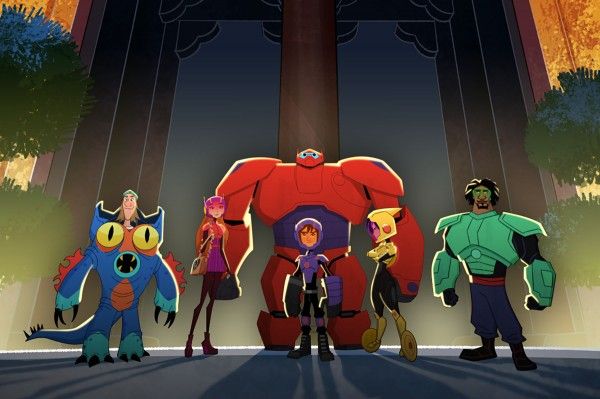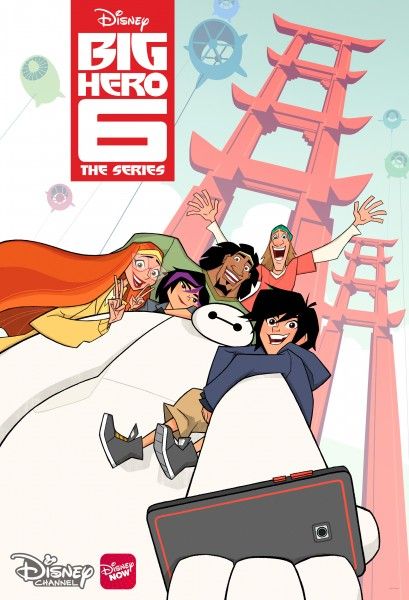Big Hero 6: The Series, based on the Walt Disney Animation Studios feature and airing on the Disney Channel, continues the adventures of 14-year-old tech genius Hiro (voiced by Ryan Potter) and his friendship with his personal healthcare companion and cutting edge robot Baymax (voiced by Scott Adsit). Along with Wasabi (voiced by Khary Payton), Honey Lemon (voiced by Genesis Rodriguez), Go Go (voiced by Jamie Chung) and Fred (voiced by Brooks Wheelan), this superhero team of six fight to protect their city from an array of villains while also trying to manage day-to-day life in San Fransokyo.
During this 1-on-1 phone interview with Collider, actor Scott Adsit talked about how the Big Hero 6 TV series evolved, the original process for figuring out how the character would sound, Baymax’s desire to always make sure Hiro is okay, whether he’d like his own personal healthcare companion, exploring new ways for how Baymax might communicate, what he most enjoys about the Baymax-Hiro dynamic, and when he realized that people might really be able to connect to and love an unusual character like Baymax.
Collider: I am very happy to be talking to you about Big Hero 6: The Series because that means we’re getting to see more of these characters.
SCOTT ADSIT: Good. I’m glad you’re excited.
When did you first learn that you’d be getting to voice this character again, for a TV series?
ADSIT: It must’ve been within a year after the premiere of the movie. I don’t know exactly when it was, but there were whispers and hints. Ryan Potter and I were backstage at a special screening at the El Capitan, and they said, We’re thinking about a sequel, but we want to get that right, so that may take a lot of time.” In the interim, there were whispers of a series. The series was set up pretty well, in the closing credits of the movie, when you saw hints of what their adventures were. I think they took that idea and just made it into a whole series, which I really like. The scripts I’ve performed and read are just wonderful. They’re really funny and smart. I was worried that a series might defuse some of the impact of movie because it’s such an emotional movie, but they’ve actually found a way to take the heart and the humor and make a series out of it without having to make a whole series about grief, which is what the movie is about. The series is about superhero-ing, and not just about grief.
Because it had been some time since you had done the movie, did you have to do anything to get back into the Baymax voice, or is he a character that comes pretty naturally for you?
ADSIT: Well, it does come pretty naturally. Baymax was never very far away because I would do occasional little jobs for Disney, or I’d do the voice for friends or acquaintances. He became a big part of my life, and has stayed right there.
When you initially were going to voice the character, did you go through a process of trying to figure out how you wanted him to sound, or did you know pretty quickly?
ADSIT: The description, when I got the material for the audition, was that he was just very benign and friendly, and he just wants to help, so I put on the most benign version of my voice, and then I infused it with a bit of an automatic phone system voice. I just thought about the most benign, bedside manner, kid friendly, adult friendly voice you’d like to have next to you while you’re sick, and this was what I came up with.
It’s cool because you get to help bring to life one of those characters that I think will always be there. You can’t forget a character like Baymax.
ADSIT: Well, here’s hoping! He’s great, for me, because he’s built to care, and to be there to pick you up and put you down and roll you over, and make sure you’re clean and diagnose you and maybe administer some medicine. And then, he’s put in these situations because of Hiro, where he’s outside of his element, but he still maintains who he is. That’s where the real fun is. He’s got one function, and then he finds that he’s got to function in a larger, more exciting world than that.
Do you think Baymax likes being a superhero, or do you think he’d rather just stick with being a personal health companion?
ADSIT: Well, he has a primary patient, who is Hiro, so he goes where Hiro goes and he makes sure that Hiro is okay. He enjoys being that for Hiro because that’s his primary function, and then a perceived friendship is happening, as well. It may be hard for him to express emotion, which he may not have. We don’t really know what’s going on inside of him. We project our emotions onto him and hope that he’s feeling that, but he is just a machine. You wonder if maybe a soul has come into being because of his relationship with Hiro, and the other four of them, and if there is something inside of him – a soul and a heart – it may be very big and very true, but he has a hard time communicating because he’s not programmed to communicate. I like to keep it a bit vague. Is there a soul in there, or is it just programming? He enjoys things, to the extent that he’s doing his job well and Hiro is safe. Hiro being safe is primarily what he’s all about. If Hiro is safe, he’s happy. If he has to fly around and be superheroic to keep Hiro safe, then he’s very happy doing that.
If personal healthcare companions were real, would you want your own personal Baymax?
ADSIT: Yeah! Who wouldn’t? He’s family. He’s like everything you’d want your family to be. He’s supportive, he listens, he understands, and he has suggestions, and then he can also administer whatever you need, even if it’s a hug.
Have you gotten to do anything new with this character for the TV series, that you weren’t able to do for the film?
ADSIT: We’ve explored a few different ways he might communicate. The format of the TV series is such that comedy is king, and we’re serving the comedy, more than anything else. And so, I think you might find Baymax in some sillier situations. He’s still Baymax, but he might have some odd responses to some things. That’s a little different, but fun. I was excited about the TV show because I always thought the characters were great and I wanted to know more about Go Go and Honey Lemon and Wasabi and Fred, to get inside their motivations and their joys and fears. We get to do that in the series.
We also get to see Hiro in college and as a full-fledged member of this team now. Does that change the dynamic between Hiro and Baymax, or is Baymax still just always going to be Baymax?
ADSIT: I think Baymax is always gonna be Baymax. He does grow a little bit, in that he’s become a little more familial with Hiro. He’s filling in of the blanks in his programming and, with each sentence, becomes smoother.
What do you most enjoy about that Baymax-Hiro dynamic?
ADSIT: I just love that it’s unconditional. Like a mother or father, or a child, or a dog, Baymax has this unconditional need to help Hiro, in whatever way he can, in the best way. There’s no other motivation beyond just giving care. It’s very simple and very straightforward. He’s learning, along the way, about what best makes him a good healthcare companion and also, by association, a good friend.
Do you guys ever get to record together, as a cast or in any pairings, or do you always have to record your voice performance alone?
ADSIT: Generally, it’s alone. I live in New York, so if the rest of the cast does get together for something in the booth, then generally I’m not in town, so I have to do it over here in New York. But we did get together, a couple times, in a big group, to record a few scenes. That was a blast because we did record the movie, individually, and we did not actually meet, as a cast. The actual six of us were not together until the very first screening at Disney Animation Studios, but we felt very much like family already. It was very strange.
For a story like this, where the group dynamic is so important to the story, it’s always interesting to hear that you don’t record as a group.
ADSIT: Yeah, and that’s down to the skill of the other actors, and the brilliance of the directors and the editors, because they understand timing and conversation. They understand how to put our words together to seem like we were in the same room. It’s astounding.
How do you find the experience of conveying a performance and bringing a character to life with just your voice?
ADSIT: I do other voice-over stuff, too, now and then, and some days, I’ll just go in and make a series of grunts because it’s a fight scene, or I’m climbing a mountain. It’s a very strange job description. I’ve done a couple of video games, and you’ll go through six hours without any real context. It’s a very strange business.
Because we’ve never really gotten to see a character like Baymax before, were you ever worried about whether he’d actually connect with audiences? And when did you realize that not only was he connecting, but that people really love him?
ADSIT: Oh, wow! First of all, thank you! When I saw the design for Baymax and the very first animation tests of how he walks, which is like a baby penguin, and he was without a face and without eyebrows, he was so expressive, which is the brilliance of the animation. I was truly convinced that they would decide, in the final edit, not to use my voice, at all, and let him be a silent character. I was absolutely convinced of that. It was near the end of it, when I was walking down the hall with some of the producers, that they said, “We had a guy who did the scratch track,” which is the rough draft of the voice for the animation people to time out everything that they’re doing because I came in about a year and a half into the four-year process. That producer very kindly said, “We were all in love with the voice and what he was doing, and we were all very sad that his voice was going, and that we were gonna bring some other actor in. And then, we heard your voice, and that was Baymax. Nobody could dispute it. We were all delighted.” That was my moment. That was a really good feeling.
Big Hero 6: The Series will launch with a premiere weekend event, featuring two back-to-back episodes on Saturday, June 9 and Sunday, June 10 on Disney Channel, DisneyNOW and Disney Channel VOD platforms, and then new episodes will air every Saturday through September.





